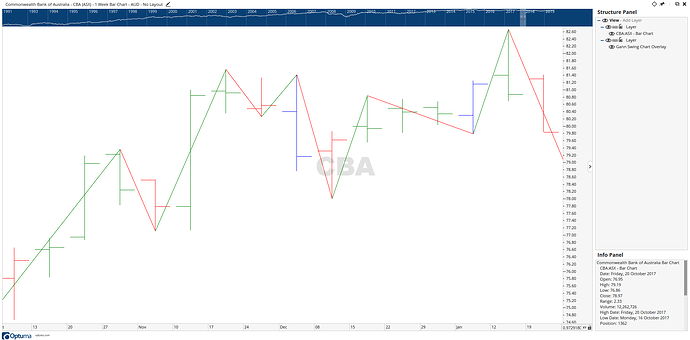Hi Johnathan and Forum,
I don’t think this is a solution for scripting a Dow Swing however, it may be of interest to you.
The MetaStock Advanced Formula Writing – Formula Primer II seems to cover identification of peaks and troughs as done by the Optuma scripting functions for Gann Swing.
The document can be found here:
https://www.metastock.com/customer/resources/formulas/Formula_Primer_II.pdf
Chapter 7 covers Pivots. Page 50 headed “Highs & Lows” which seems to describe Dow Swings.
The text works through various algorithms to identify peaks and troughs.
I have made translations from MetaStock Formula Language to Optuma Scripting Language. My formulas complete without error but do not work.
I have tried some in MetaStock and they produce a binary wave which lines up correctly with peaks. I attempted to apply the formulas to the MetaStock Expert without success. I am not well versed with MetaStock as I find Optuma is a way more friendly and capable charting package to use.
Here are my various translations:
Page 51 under heading “Step3: The Final Formula”
HIGH() > VALUEWHEN(HIGHESTHIGH(BARS=40), -1) and HIGH() > VALUEWHEN(HIGH(), +1)
Page 53 under heading “Step3: The Final Formula”
bar1 = VALUEWHEN(high(OFFSET=-2)) > HIGHESTHIGH(BARS=2) and
VALUEWHEN(high(OFFSET=-2)) > VALUEWHEN(HIGHESTHIGH(BARS=2),-3);
bar2 = VALUEWHEN(high(OFFSET=-2)) > HIGHESTHIGH(BARS=2) and
VALUEWHEN(high(OFFSET=-2)) = VALUEWHEN(high(OFFSET=-3)) and
VALUEWHEN(high(OFFSET=-2)) > VALUEWHEN(HIGHESTHIGH(BARS=2), -4);
bar3 = VALUEWHEN(high(OFFSET=-2)) > HIGHESTHIGH(BARS=2) and
VALUEWHEN(high(OFFSET=-2)) = VALUEWHEN(high(OFFSET=-3)) and
VALUEWHEN(high(OFFSET=-2)) = VALUEWHEN(HIGHESTHIGH(BARS=2), -5);
bar2nc = VALUEWHEN(high(OFFSET=-2)) > HIGHESTHIGH(BARS=2) and
VALUEWHEN(high(OFFSET=-2)) = VALUEWHEN(high(OFFSET=-3)) and
VALUEWHEN(high(OFFSET=-2)) = VALUEWHEN(HIGHESTHIGH(BARS=2), -5);
bar3nc = VALUEWHEN(high(OFFSET=-2)) > HIGHESTHIGH(BARS=2) and
VALUEWHEN(high(OFFSET=-2)) = VALUEWHEN(high(OFFSET=-4)) and
VALUEWHEN(high(OFFSET=-2)) = VALUEWHEN(high(OFFSET=-6)) and
VALUEWHEN(high(OFFSET=-2)) = VALUEWHEN(high(OFFSET=-3)) and
VALUEWHEN(high(OFFSET=-2)) = VALUEWHEN(high(OFFSET=-5)) and
VALUEWHEN(high(OFFSET=-2)) = VALUEWHEN(HIGHESTHIGH(BARS=2), -7);
bar1 or ba3 or bar3nc or bar2nc or bar3nc
Page 56 under heading “Step3: The Final Formula”
mu= HIGH() > MAX(high(OFFSET=-1), high(OFFSET=1));
p2 = mu and HIGH() > VALUEWHEN() (2, mu, HIGH());
p3 = mu and HIGH() < VALUEWHEN()(2, mu, HIGH()) and VALUEWHEN(2, mu, p2);
time = LAST(MAX(VALUEWHEN(1, p3, BARCOUNT(p2))));
x = VALUEWHEN(1, p3, ACC(RANGE=Look Back Period, BARS=1) - BARCOUNT(p2));
mju = ACC(RANGE=Look Back Period, BARS=1) == VALUEWHEN(x, time);
pj2 = mju and HIGH() > VALUEWHEN(2, mju, high());
pj3 = mju and HIGH() < VALUEWHEN(2, mju, high()) and VALUEWHEN(2, mju, pj2);
timej = LAST(MAX(VALUEWHEN(1, p3, BARCOUNT(pj2))));
xj = VALUEWHEN(1, pj3, ACC(RANGE=Look Back Period, BARS=1) - BARCOUNT(pj2));
ACC(RANGE=Look Back Period, BARS=1) == VALUEWHEN(x, time) or ACC(RANGE=Look Back Period, BARS=1) == VALUEWHEN(xj, timej)
Cheers, Lester



